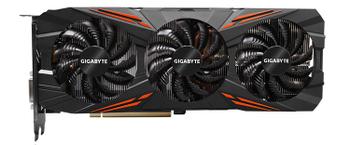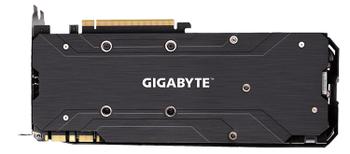Introduction
A review of an aftermarket GeForce GTX 1080 is really an evaluation of the how well an add-in card (AIC) partner has designed their PCB and cooling system. The best Pascal GPU pulls no more than 180W under load, according to Nvidia, and even if we add on 20 per cent more power for third-party boards that are overclocked, cooling a sub-220W package is meat and drink to any quality cooler, especially as they've been tasked to handle significantly more from the last generation's best GPUs.
What we're seeing when viewing cards is newer generations of coolers from all and sundry. That theme is continued by the next GTX 1080 on the block, coming in from dual-source partner Gigabyte. Three versions are listed: the FE, a mid-spec G1 Gaming, and a daddy board known as the Xtreme Gaming, priced at £620, £630 and £675, respectively.
£630 is a fee that is far from value, of course, but it's considered the regular kind of price for aftermarket GTX 1080s. That outlay brings the G1 Gaming into view, equipped with a new cooler for the 10-series GPUs. Gigabyte continues with the WindForce tri-fan cooler but with new livery that's pleasing on the eye.
The debate as to whether two large fans or three medium-sized ones are better depends on which AIC you speak to. Gigabyte clearly favours the latter, with three 90mm spinners using a new fan-blade design this time around. As usual, the trio are silent at temperatures below 60°C or so, then ramp up steadily as load is increased.
Given the oversized PCBs we've seen on other GTX 1080s - in both width and height - the G1 Gaming is a picture of reserve. 286mm long, 115mm high and 42mm tall, it is the smallest AIC card to pass through the labs.
As standard, the card chimes in at 1,696MHz base and 1,835MHz boost, rising to 1,721/1,860MHz when running in OC mode via software. The core clock is middling for an AIC-produced card and this has as much to do with the relatively low headroom on the GTX 1080 GPU than lack of ambition on Gigabyte's part. Memory, meanwhile, is a stock 10,000MHz in both states. Our sample adhered to Gigabyte's prescribed out-of-the-box frequencies.
Lending strength and enhancing the look is a solid rear backplate that gets surprisingly warm under load; certainly warmer than any other GTX 1080 AIC card we've tested, inferring that it is doing a good job of ferrying the heat from the back of the card and out into the chassis. Helping in this regard are a couple of thermal pads that sit between the plate and the rear of the PCB. Dual SLI fingers pave the way for two-way SLI now that Nvidia has limited its multi-GPU technology to just a couple of 10-series cards.
Here's something different. Every other AIC we care to mention adds a six-pin connector on top of the Founders Edition eight-pin, but not Gigabyte, thus potentially limiting just how far it can be pushed. There's a semi-pointless 'fan stop' logo that lights up when the fans stop spinning. This logo uses the same configurable RGB lighting as the main Gigabyte logo in the middle, and both are tweaked using Gigabyte's Xtreme utility. Per the status quo amongst these types of card, the lighting can be set to one of five modes - cycling, breathing, flash, dual flash, and consistent.
Though the similarities between PCB length and eight-pin power connector may infer that Gigabyte has simply chosen the reference PCB and run with it for the G1 Gaming, this is not true; the boards are different; Gigabyte's is a little longer and has a trio of extra power phases for the core and one more for the memory.
What's of more interest is how Gigabyte chooses to cool the remainder of the card. Other manufacturers, such as MSI and Asus, have their respective coolers make contact with the core alone; other heatsinks provide passive cooling for the memory and VRM circuitry. The idea is that the downward air pressure from the cooler's fans is enough to keep those components at reasonable temperatures.
Gigabyte, on the other hand, uses its tri-heatpipe cooler to provide direct contact and cooling by way of thick thermal pads between heatsink and other hot-running components. Its premise is that the RAM and choke/MOSFETs needs more than a small passive heatsink; the main cooler's TDP-wicking ability should be used instead. We'll see how this translates in the power and temperature section of the review.
Gigabyte thankfully does not meddle with the outputs on the rear, matching the triple DisplayPort, single HDMI and dual-link DVI of the Founders Edition card. A little cheaper than most other AIC cards but still backed by the same three-year warranty, let's now see if Gigabyte can match them in the benchmark stakes.






